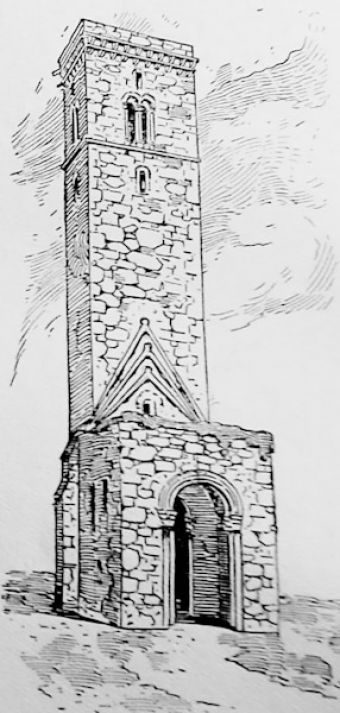
A half Saxon royal family was established on the throne of Scotland when Edgar seized the throne during the reign of William Rufus in England. Since the reconciliation of Edgar the AEtheling with the Norman, the undercurrent of hostility to the Norman dynasty in England disappeared among the sons of Malcolm Canmore and Margaret.
Those princes in fact, themselves, now represented the hereditary claims of the house of Wessex, any attempt to assert which would have been particularly absurd in view of the relations between King Edgar and William Rufus.
When Henry I married King Edgar's sister, the family claims, such as they were, were absorbed by the offspring of that marriage. But it is curious to observe that on the principles of pure legitimacy the kings, of Scotland were the rightful kings of England, not the Norman line, which, on feudal principles, periodically put in its own claim to the overlordship of Scotland.
Alexander I
Three brothers now reigned in succession. When Edgar died, Alexander I became, king with his capital at Edinburgh; but even during his reign the last brother, David, as Earl of Southern Scotland, was practically the ruler of the whole of the Lowlands, David was in constant contact with the English; and his wife was the daughter of Waltheof.
Alexander himself was considerably occupied with the repression of the rebellious Celts of the North, and with the Anglicising or Normalising of the ecclesiastical organisation; although he was extremely careful to avoid doing anything which could be construed into a subjection of the Church of Scotland to the supremacy either of Canterbury or York, Perhaps if Alexander had left a son, Scotland might have been parted into two kingdoms. As he was childless, David ascended the throne in 1124.
King David
David's reign of twenty-nine years established the character ot the Scottish kingdom, both through his failures and his successes. It was his ambition to obtain the northern earldoms of England and absorb them into the Scottish kingdom; but though he procured from Stephen the grant of Northumberland, he did not succeed in absorbing it. Tweed and Solway remained the lasting boundaries between the kingdoms.
The Normanising of Scotland
It was not to these ambitions that the great importance of David's reign must be attributed. It is to be found rather in the Normanising of the southern aristocracy, in the organisation of the Church and the extension of its influence, and in the municipal development which he fostered.
The elements which went to make up the Scottish state proved to be much more difficult of combination than those in England, when Norman feudalism and English institutions blended together. There the Crown took the people into partnership in order to hold the lawlessness of the barons in check; then the barons took the people into partnership in order to hold the lawlessness of the Crown in check.
The Church generally took the side of the law, except when it followed an aggressive line on its own account, when the king and the barons made common cause against it. The Celtic element was always insignificant. But in Scotland the Celtic element was always active, and there were constant cross currents of Celtic-tribalism in the North and Norman feudalism in the South, both acting against the central government, which was on the other hand, constantly in close alliance with the Church against both Celtic and Norman nobility.
The effect of David's Normanising and ecclesiastical policy was in the first instance pre-eminently civilising, and Scottish culture attained a higher standard in many respects than that of England. Scotland became a nation, and developed a sense of nationality which enabled it to set Us far more powerful neighbour at defiance; though the warring elements. of which the nation was composed kept it internally in a state of anarchy which was hardly checked except by the unifying influence of the common hostility to England.
But all this did not become apparent in the reign of David I, or indeed, for long afterwards. What was apparent in that reign, which ended a year before the death of Stephen, was that Scotland had emerged definitely in the character of a state developing on the lines of European civilisation; lines, that is, partly Teutonic and partly Latin; not on the un-Latinized and un-Teutonized Celtic lines which she had been following down to the accession of Malcolm Canmore.
The politically predominant division of Scotland approximated not to Ireland or to Wales, but to England; and her future relations with England were for a time at least to be seriously complicated by the fact that the great barons of the Lowlands for the most part held fiefs in England as well, and were vassals at once of the two kings of England and Scotland.
This article is excerpted from the book, 'A History of the British Nation', by AD Innes, published in 1912 by TC & EC Jack, London. I picked up this delightful tome at a second-hand bookstore in Calgary, Canada, some years ago. Since it is now more than 70 years since Mr Innes's death in 1938, we are able to share the complete text of this book with Britain Express readers. Some of the author's views may be controversial by modern standards, particularly his attitudes towards other cultures and races, but it is worth reading as a period piece of British attitudes at the time of writing.
History
Prehistory - Roman
Britain - Dark Ages - Medieval
Britain - The Tudor Era - The
Stuarts - Georgian Britain - The Victorian Age
